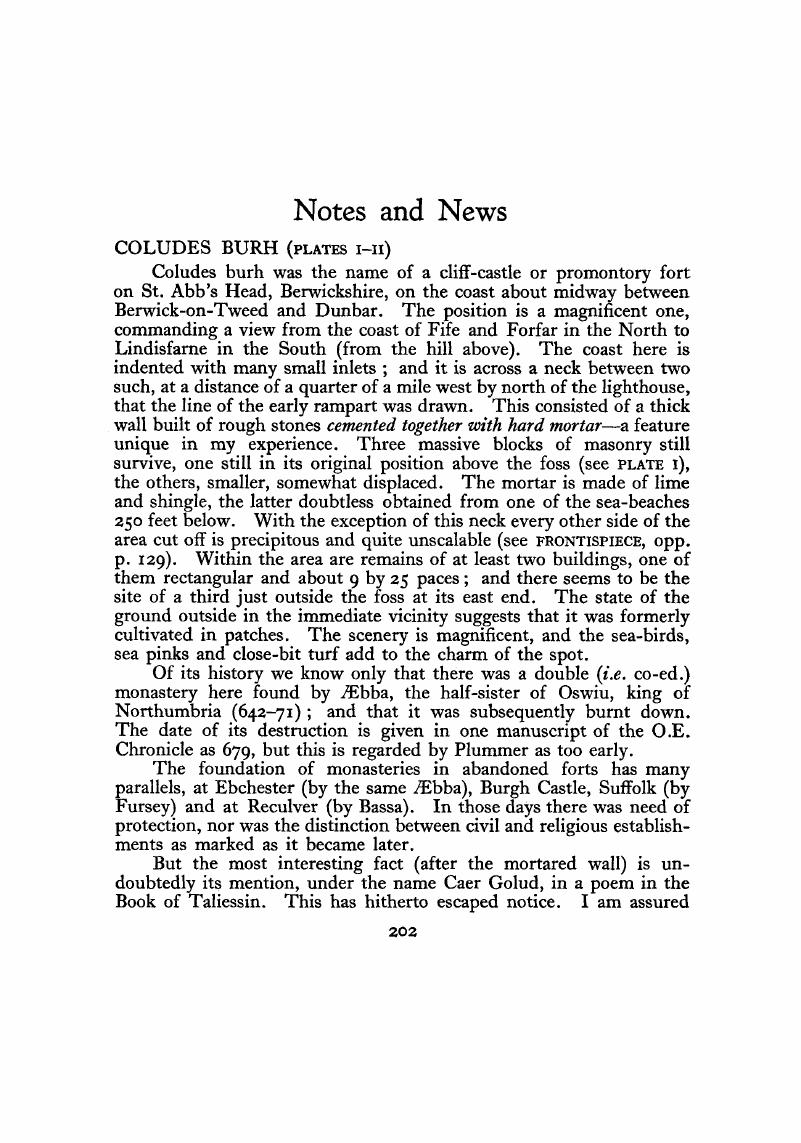No CrossRef data available.
Article contents
Abstract
An abstract is not available for this content so a preview has been provided. Please use the Get access link above for information on how to access this content.

- Type
- Notes and News
- Information
- Copyright
- Copyright © Antiquity Publications Ltd 1934
References
Historicarel Rerences
Episcopi, Vita Wilfridi, auctore Stephano, Eddio, cap. XXXIX (Rolls Series, Historians of the Church of York, ed. Jas. Raine, 1879, I, 55): ‘. . . coenobium quod Colodaesburg dicitur . . . cui praesidebat sanctissima materfamilias nomine Æbbae, soror Oswini regis sapientissima’.Google Scholar
Bede, , Hist. Eccles. cap. XVII (Plummer, 1896, I, 243): ‘ . . . monasterium Æbbae abbatissae, quae erat amita [aunt] regis Ecgfridi, positum in loco quem Coludi urbem nominant ‘.Google Scholar
Bede, , Hist. Eccles. cap. XXIII (Plummer, 1896, I, 262) : ‘ His temporibus monasterium virginum quod Coludi urbem cognominant, cuius et supra meminimus, per culpam incuriae flammis absumtum est ‘. (There follows the tale of Adamnan the Scot who was leading a life of prayer and continence there, consisting of eating and drinking only on Thursdays and Sundays and often praying all night. Bede then recounts the story of his sin and repentance, and of how he prophesied the destruction of Coludes burh as a divine judgment for its corruptions).Google Scholar
Cuthberti, Vita S., Auct. Anon : ‘Veniens ergo [S. Cuthbertus], ut invitatus est ad coenobium quod dicitur Colodes byrig, manensque ibi aliquot dies . . .’ [Ven. Bedae op. hist. min., ed. Stevenson, J., 1841, p. 266, corrected].Google Scholar
Cudbercti, Vita S., auct. Ven. Beda : ‘Erat sanctimonialis femina et mater ancillarum Christi, nomine Ebbe, regens monasterium, quod situm est in loco quem Coludi urbem nuncupant’ [ib. id. pp. 68, 69.Google Scholar
Chronicle, Anglo-Saxon, s. a. 679 : ‘ Coludes burh for barn mid godcundum fyre (celico igni, F.) ’ : Coludes burh was burnt with divine fire. (Copied from Bede).Google Scholar
Eliensis, Liber, p. 38 : ‘ Coldeburches hevet, quod latine caput Coldeburci dicitur’. Capgrave I, 303-4 : ‘ montem Coludi, id est Coldingham ’.Google Scholar
Book of Taliessin, xxx : ‘Namyn seith ny dyrreith o gaer golud’ (except seven none Skene, W. F., Four Ancient Books of Wales, 1868, I, . returned from Caer Golud). 265,11, 182.Google Scholar




